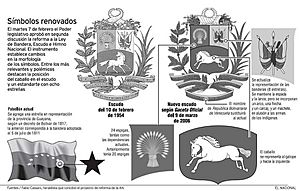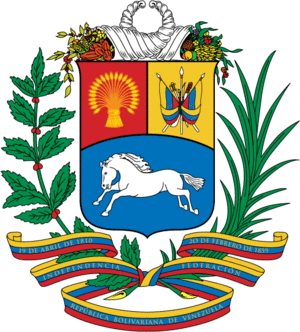Coat of arms of Venezuela facts for kids
Quick facts for kids Coat of arms of Venezuela |
|
|---|---|
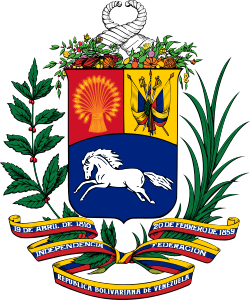 |
|
| Versions | |
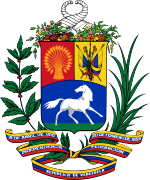
1954−2006
|
|
| Armiger | Bolivarian Republic of Venezuela |
| Adopted | March 12, 2006 |
| Motto | 19 DE ABRIL DE 1810 - INDEPENDENCIA (April 19, 1810 - Independence) |
The coat of arms of Venezuela is an important national symbol. It was first approved on April 18, 1836. Over the years, it has been changed a few times to reach its current look.
The design of the coat of arms is set by the "Law of the National Flag, Shield and Anthem." This law was passed on February 17, 1954. The shield part of the coat of arms uses the same colors as the Venezuelan flag.
Contents
Understanding the Symbols on the Shield
The shield is divided into three colorful sections, each with special meanings.
Red Section: Unity and Wealth
The top left part of the shield is red. In this section, you'll see a bundle of wheat. This wheat stands for the unity of the 20 states that existed in Venezuela at that time. It also represents the country's wealth.
Yellow Section: Victory and Freedom
The top right part of the shield is yellow. Here, you can see different weapons like a sword, a sabre, and three lances. Two Venezuelan flags are also shown. These items are tied together with a branch of laurel. This part of the shield symbolizes victory in war and the triumph of the Venezuelan people.
Blue Section: Independence and Liberty
The bottom part of the shield is deep blue. On this blue background, a wild white horse is running freely. This horse represents Simón Bolívar's famous white horse, Palomo. The running horse is a strong symbol of independence and freedom for Venezuela.
Elements Around the Shield
Above the main shield, there are two crossed cornucopias, which are like horns overflowing with good things. These show the country's abundance and wealth.
The shield is framed by two branches: an olive branch and a palm branch. These branches are tied together at the bottom with a large ribbon. This ribbon has the three colors of the national flag:
- Yellow: Represents the nation's wealth.
- Blue: Stands for the ocean that separates Venezuela from Spain.
- Red: Symbolizes the blood and courage of the Venezuelan people.
On the blue stripe of this ribbon, you can read important messages in golden letters:
| 19 de Abril de 1810 (April 19, 1810) | 20 de Febrero de 1859 (February 20, 1859) |
| Independencia (Independence) | Federación (Federation) |
| República Bolivariana de Venezuela (Bolivarian Republic of Venezuela) | |
These dates and words remind Venezuelans of key moments in their history: their independence and the idea of a federation.
Changes Made in 2006
On March 7, 2006, the National Assembly decided to change the coat of arms and the flag of Venezuela. These changes became official on March 12, 2006, which is Flag Day in Venezuela.
The Horse's New Direction
One of the most noticeable changes was the direction of the white horse. Before 2006, the horse ran to the right side of the shield, looking back to the left. In the new design, the horse runs to the left side of the shield.
In heraldry (the study of coats of arms), animals usually face the right side of the shield. This is seen as the natural and honorable way. Some people say the change was suggested by the president's daughter. However, government officials stated that both the lawmakers and the president agreed on the changes.
New Symbols Added
Other changes included adding a machete. This tool represents the peasant fighters who fought in Venezuela's revolutionary wars. A bow and arrow were also added. These honor the brave indigenous people who resisted the Spanish explorers.
The new direction of the horse also has a special meaning. It symbolizes Venezuela being the first independent country in South America. It also represents Simon Bolivar's efforts to free all of Latin America. His campaigns started in Venezuela in 1810 and ended with his victory in the Battle of Ayacucho in 1824. He rode his white horse, Palomo, during these campaigns.
At first, some people disagreed with the changes. However, over time, the new coat of arms and flag have become widely accepted by most Venezuelans. The new design of the national coat of arms was created by a heraldist named Fabio Cassani Pironti.
How the Coat of Arms Changed Over Time
The coat of arms of Venezuela has changed many times throughout history. Here's a look at some of its past versions:
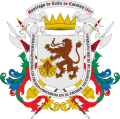 |
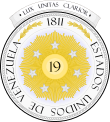 |
 |
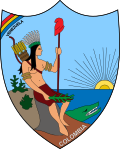 |
 |
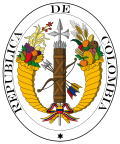 |
| Province of Venezuela | First Republic of Venezuela | Second Republic of Venezuela | Third Republic of Venezuela | Gran Colombia | Gran Colombia |
| 1777–1811 | 1811–1812 | 1812–1814 | 1814–1819 | 1819–1821 | 1821–1830 |
 |
 |
 |
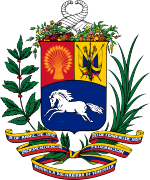 |
|
| State of Venezuela | State of Venezuela | United States of Venezuela | Republic of Venezuela | Bolivarian Republic of Venezuela |
| 1830–1836 | 1836–1864 | 1864–1954 | 1954–2006 | 2006–present |
See also
 In Spanish: Escudo de Venezuela para niños
In Spanish: Escudo de Venezuela para niños


